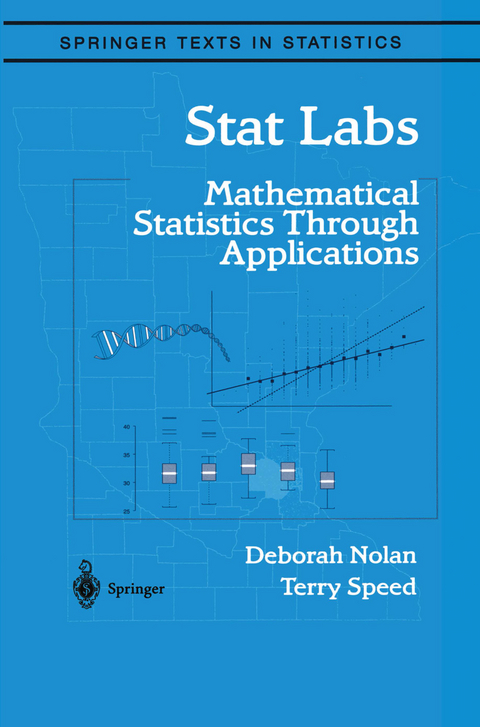
Stat Labs
Mathematical Statistics Through Applications
Seiten
2000
Springer-Verlag New York Inc.
978-0-387-98974-7 (ISBN)
Springer-Verlag New York Inc.
978-0-387-98974-7 (ISBN)
This book uses a model we have developed for teaching mathematical statistics through in depth case studies. In addition to providing the framework and motivation for studying topics in mathematical statistics, the labs help students develop statistical thinking.
This book uses a model we have developed for teaching mathematical statistics through in depth case studies. Traditional statistics texts have many small numer ical examples in each chapter to illustrate a topic in statistical theory. Here, we instead make a case study the centerpiece of each chapter. The case studies, which we call labs, raise interesting scienti?c questions, and ?guring out how to answer a question is the starting point for developing statistical theory. The labs are substan tial exercises; they have nontrivial solutions that leave room for different analyses of the data. In addition to providing the framework and motivation for studying topics in mathematical statistics, the labs help students develop statistical thinking. We feel that this approach integrates theoretical and applied statistics in a way not commonly encountered in an undergraduate text. The Student The book is intended for a course in mathematical statistics for juniors and seniors. We assume that students have had one year of calculus, including Taylor series, and a course in probability. We do not assume students have experience with statistical software so we incorporate lessons into our course on how to use the software.
This book uses a model we have developed for teaching mathematical statistics through in depth case studies. Traditional statistics texts have many small numer ical examples in each chapter to illustrate a topic in statistical theory. Here, we instead make a case study the centerpiece of each chapter. The case studies, which we call labs, raise interesting scienti?c questions, and ?guring out how to answer a question is the starting point for developing statistical theory. The labs are substan tial exercises; they have nontrivial solutions that leave room for different analyses of the data. In addition to providing the framework and motivation for studying topics in mathematical statistics, the labs help students develop statistical thinking. We feel that this approach integrates theoretical and applied statistics in a way not commonly encountered in an undergraduate text. The Student The book is intended for a course in mathematical statistics for juniors and seniors. We assume that students have had one year of calculus, including Taylor series, and a course in probability. We do not assume students have experience with statistical software so we incorporate lessons into our course on how to use the software.
Maternal Smoking and Infant Health.- Who Plays Video Games?.- Minnesota Radon Levels.- Patterns in DNA.- Can She Taste the Difference?.- HIV Infection in Hemophiliacs.- Dungeness Crab Growth.- Calibrating a Snow Gauge.- Voting Behavior.- Maternal Smoking and Infant Health (continued).- A Mouse Model for Down Syndrome.- Helicopter Design.
| Reihe/Serie | Springer Texts in Statistics |
|---|---|
| Zusatzinfo | XVIII, 283 p. |
| Verlagsort | New York, NY |
| Sprache | englisch |
| Maße | 155 x 235 mm |
| Themenwelt | Mathematik / Informatik ► Mathematik ► Angewandte Mathematik |
| Mathematik / Informatik ► Mathematik ► Logik / Mengenlehre | |
| Mathematik / Informatik ► Mathematik ► Wahrscheinlichkeit / Kombinatorik | |
| ISBN-10 | 0-387-98974-9 / 0387989749 |
| ISBN-13 | 978-0-387-98974-7 / 9780387989747 |
| Zustand | Neuware |
| Haben Sie eine Frage zum Produkt? |
Mehr entdecken
aus dem Bereich
aus dem Bereich
Anwendungen und Theorie von Funktionen, Distributionen und Tensoren
Buch | Softcover (2023)
De Gruyter Oldenbourg (Verlag)
CHF 97,90


